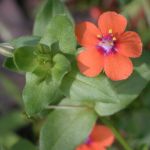| Common Name: |
Scarlet Pimpernel |
| Other Names: |
Poor man's weatherglass |
| Botanical Name: |
Anagallis arvensis |
| Genus: |
Anagallis |
| Family: |
Primulaceae |
| Native Location: |
Europe |
| Cultivation: |
Well-drained to dry or sandy soil in sun. Aphids may attack plants under cover. |
| Propagation: |
By seed sown in spring at 16-18°C (61-64°F) |
| Harvest: |
Whole plants are gathered in summer and used fresh, often as expressed juice, or dried for infusions, liquid extracts, tinctures, and powder. |
| Height: |
2.5-5cm (1-2in) |
| :Width |
15-30cm (6-12in) |
| Variations: |
caerulea
(Blue pimpernel)
Has gentian-blue flowers |
| Hardiness: |
Z7-10 |
| Parts Used: |
Whole plant |
| Properties: |
An acrid, mucilaginous herb that lowers fever and has diuretic and expectorant effects. |
| Medicinal Uses: |
Traditionally prescribed internally for depression, tuberculosis, liver complaints, epilepsy, dropsy, and rheumatism. No longer considered safe by most medical herbalists, but of interest to medical researchers. Externally, as pimpernel water, for improving the complexion, especially for freckles. |
| Warning: |
Harmful if eaten. |
| Bibliography: |
Encylopedia of Herbs by Deni Brown Copyright ©: 1995, 2001 Dorling Kindersley Limited pg 119-120
|

